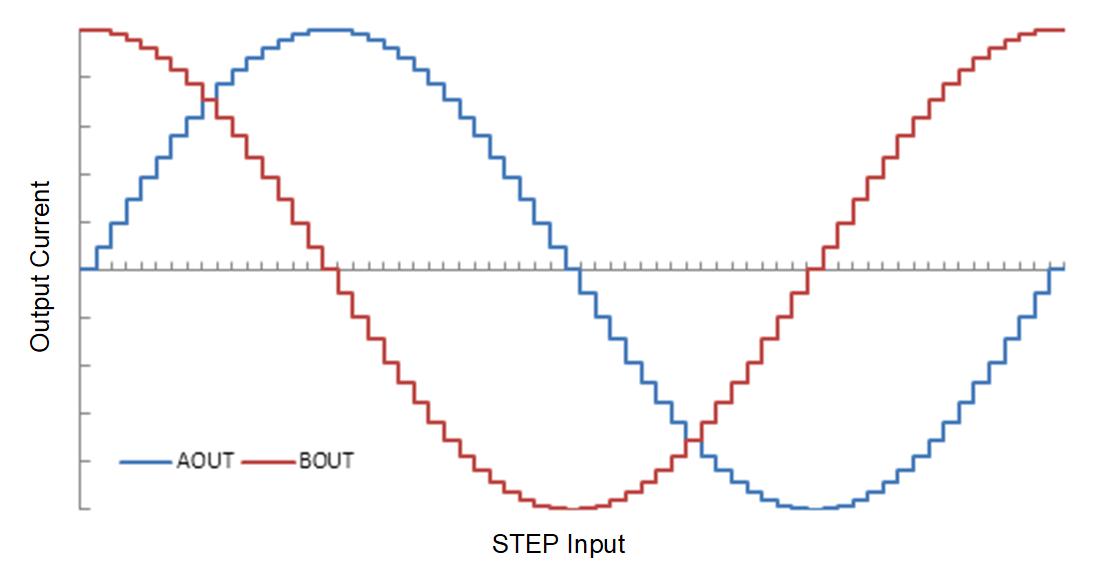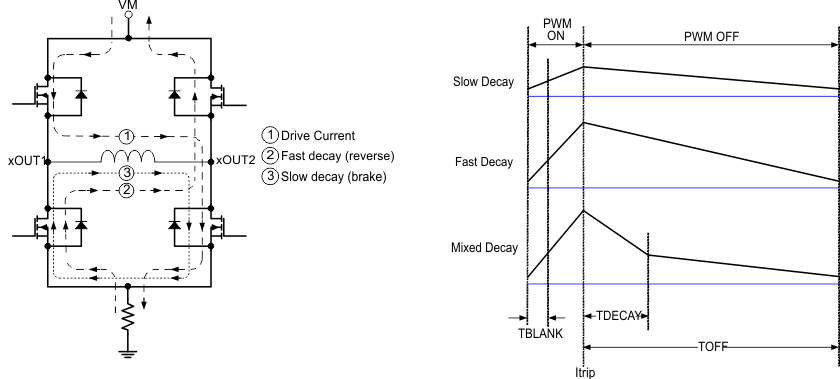SLVAES8 May 2020 DRV8424 , DRV8424E , DRV8426 , DRV8428 , DRV8428E , DRV8434 , DRV8434E , DRV8434S , DRV8436 , DRV8436E , DRV8889-Q1
1 Introduction
Stepper motors are used in a wide array of applications such as printers, projectors, textile machines, stage lighting, industrial automation, electronic point of sale, automotive headlight, and head-up display. A stepper motor moves in discrete steps as defined by a step angle during its rotation. It has two electrical current windings and each winding can be controlled with an H-Bridge. As shown in Figure 1, the stepper motor driver applies current waveforms approximating a sine wave (blue) into one coil and a cosine wave (red) into the other. One quadrant (90°) of the current waveforms corresponds to the stepper motor rotation by one step angle, which is 1.8° for most hybrid stepper motors used today.
 Figure 1. Microstepping Current Waveform
Figure 1. Microstepping Current Waveform Most stepper motor drivers limit current by "chopping" their drive output at some frequency, called the PWM frequency. During PWM current chopping, the H-bridge is enabled to drive through the motor winding until the PWM current chopping threshold is reached. This is shown in Figure 2, Item 1.
Once the chopping current threshold is reached, the H-bridge can operate in two different states, fast decay or slow decay. In fast decay mode, once the PWM chopping current level has been reached, the H-bridge reverses state to allow winding current to flow in a reverse direction. The opposite FETs are turned on; as the winding current approaches zero, the bridge is disabled to prevent any reverse current flow. Fast decay mode is shown in Figure 2, item 2. In slow decay mode, winding current is re-circulated by enabling both of the low-side FETs in the bridge. This is shown in Figure 2, Item 3. Most legacy stepper drivers feature a fixed-percentage mixed decay scheme, where the decay mode is fast decay for a fixed percentage of the OFF time, and slow decay for the rest of the OFF time.
 Figure 2. Decay Modes
Figure 2. Decay Modes With traditional slow, fast and mixed decay modes, stepper motors can be known to hum and whine as they operate. In most applications, the audible noise can annoy users and might warrant expensive noise suppression methods, such as rubber isolators, which do not completely eliminate the noise. For example, household or office printers and 3D printers have multiple stepper motors within them, and the noise from the motors can break concentration of their users. Higher quality stepper motor drivers that can reduce the motor noise go a long way towards user satisfaction. Another example is electric vehicles, which are generally quiet due to the absence of an internal combustion engine, and lowering the noise level from stepper motors used in headlight leveling helps to achieve a overall quiet cabin.
In the following sections, we will discuss the various sources of noise in stepper motors and how different stepper motor driver features can alleviate most of that noise.